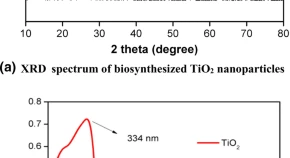Eco friendly synthesis of TiO2 nanoparticles using aqueous Ocimum americanum L. leaf extracts and their antimicrobial, anti-proliferative and photocatalytic activities
Vijayakumar S., Vidhya E., Anand G. Chinnu, Nilavukkarasi M., Punitha V. N., Sakthivel B.
Short Communications | Published: 02 September, 2020
First Page: 805
Last Page: 810
Views: 3611
Keywords: Green synthesis, Ocimum americanum , TiO2 , Antimicrobial, Antiproliferative, Photodegradation
Abstract
Bio-synthesis of TiO2 nanoparticles was accomplished with Ocimum americanum L leaf extracts. The morphology, optical and functional properties of synthesized TiO2 nanoparticles were characterized by XRD, UV–Vis spectroscopy, FT-IR, and FE-SEM with EDAX respectively. The aqueous extracts of these nanoparticles were evaluated for its antimicrobial activities against Bacillus cereus, Clostridium perfringens, Salmonella paratyphi, Klebseilla pnemoniae, Candida albicans and Aspergillus niger using an agar well method. The antiproliferative activity was analyzed by MTT assay. Photocatalytic analysis against methylene blue dye was investigated. The biosynthesized TiO2 nanoparticles was analyzed by SEM with an average size of the particle was 25 nm. The synthesized TiO2 nanoparticles were exhibited excellent antimicrobial and antiproliferation activities against selected pathogens and human skin cancer cell line (431) respectively and expression of admirable photocatalytic activity with reduction of 91.1%. Based on the above studies, it is concluded that these nanoparticles are eco-friendly, inexpensive and pollution free material which can be applied for multifaceted environmental applications.

References
- Abisharani JM, Devikala S, Dinesh Kumar R, Arthanareeswari M, Kamaraj P (2019) Green synthesis of TiO2 nanoparticles using Cucurbita pepo seeds extract. Mater Today Proc 14:302–307. https://doi.org/10.1016/j.matpr.2019.04.151
- Baskar D, Nallathambi G (2017) Dual functional property of lycopene as a reducing agent to synthesise TiO2 nanoparticles and as a ligand to form lycopene-TiO2 nanoparticles complex. Mater Lett 209:303–306
- Debjani N, Pratyusha B (2013) Green nanotechnology—a new hope for medical biology. Environ Toxicol Pharmacol 36:997–1014. https://doi.org/10.1016/j.etap.2013.09.002
- Emam MA, Khattab HI, Hegazy MGA (2019) Assessment of anticancer activity of Pulicaria undulata on hepatocellular carcinoma HepG2 cell line. Tumour Biol. https://doi.org/10.1177/1010428319880080
- He F, Yu W, Fan X, Jin B (2017) In vitro cytotoxicity of biosynthesized titanium dioxide nanoparticles in human prostate cancer cell lines. Trop J Pharm Res 16(12):2793–2799. https://doi.org/10.4314/tjpr.v16i12.2
- Khade GV, Suwarnkar MB, Gavade NL, Garadkar KM (2015) Green synthesis of TiO2 and its photocatalytic activity. J Mater Sci Mater Electron 26:3309–3315. https://doi.org/10.1007/s10854-015-2832-7
- Mobeen Amanulla A, Sundaram R (2019) Green synthesis of TiO2 nanoparticles using orange peel extract for antibacterial, cytotoxicity and humidity sensor applications. Mater Today Proc 8:323–331. https://doi.org/10.1016/j.matpr.2019.02.118
- Mustapha FH, Jail AA, Mohamed M, Triwahyono S, Hassan NS, Khusnun NF, Hitam CNC, Rahman AFA, Firmanshah L, Zolkifil AS (2017) New insight into self-modified surfaces with defect-rich rutile TiO2 as a visible-light-driven photocatalyst. J Clean Prod 168:1150–1162
- Rajakumar G, Rahuman AA, Priyamvada B, Khanna VG, Kumar DK, Sujin PK (2012) Eclipta prostrata leaf aqueous extract mediated synthesis of titanium dioxide nanoparticles. Mater Lett 68:115–117. https://doi.org/10.1016/j.matlet.2011.10.038
- Reddy PR, Shimoga D, Nabanita S, Oyunchimeg Z, Petr S (2016) Ecofriendly synthesis of silver nanoparticles from garden rhubarb (Rheum rhabarbarum). J Nanotechnol 4964752:1–9. https://doi.org/10.1155/2016/4964752
- Dobrucka R (2017) Synthesis of titanium dioxide nanoparticles using Echinacea purpurea herba. Iran J Pharm Res 16(2):756–762
- Dobrucka R, Długaszewska J (2016) Biosynthesis and antibacterial activity of ZnO nanoparticles using Trifolium pratense flower extract. Saudi J Biol Sci 23:517–523. https://doi.org/10.1016/j.sjbs.2015.05.016
- Bagheri S, Shameli K, Abd Hamid SB (2013) Synthesis and characterization of anatase titanium dioxide nanoparticles using egg white solution via sol-gel method. J Chem 2013:848205. https://doi.org/10.1155/2013/848205
- Subhapriya S, Gomathipriya P (2018) Green synthesis of titanium dioxide (TiO2) nanoparticles by Trigonella foenum-graecum extract and its antimicrobial properties. J Microb Pathog 116:215–220. https://doi.org/10.1016/j.micpath.2018.01.027
- Tristram S, Jacobs MR, Applebaum PC (2007) Antimicrobial resistance in Haemophilus influenzae. Clin Microbiol Rev 20:368–389. https://doi.org/10.1128/CMR.00040-06
- Nadtochenko V, Denisov N, Sarkisov O, Gumy D, Pulgarin C, Kiwi J (2006) Laser kinetic spectroscopy of the interfacial charge transfer between membrane cell walls of E. coli and TiO2. J Photochem Photobiol A Chem 181(2–3):401–407. https://doi.org/10.1016/j.jphotochem.2005.12.028
Author Information
Computational Phytochemistry Laboratory, PG and Research Department of Botany, AVVM Sri Pushpam College (Autonomous) Poondi, Thanjavur, India